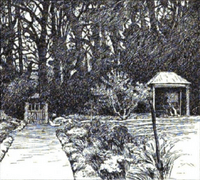Farringford House facts for kids


Farringford House is a famous home located in Freshwater Bay on the Isle of Wight. It was the beloved home of the well-known poet Alfred, Lord Tennyson, from 1853 until he passed away in 1892. This historic house has a long story, starting in 1806. Over the years, it gained beautiful gothic decorations and extensions, especially in the 1830s.
Today, Farringford House is a special place where you can learn about Tennyson's life. After being a hotel for many years, it was carefully restored and opened in 2017 as a historic house and museum. You can take guided tours from April to October to explore the house and its lovely grounds. It also hosts creative workshops, concerts, and exhibitions. If you want to stay longer, there are ten self-catering cottages on the estate, open all year round, along with a tennis court and a play area for kids.
Contents
Exploring Farringford House
Farringford House has many interesting features. The main building was first built in 1806. Later, in the 1830s, it was given a more dramatic and old-fashioned look with gothic additions. These changes made the house look like something out of a storybook!
Tennyson's Special Spaces
One very important part of the house is the second library. Tennyson's wife, Emily Tennyson, had it built in 1871. Below the library was a playroom, and these two rooms were connected by a winding staircase inside a small tower. Imagine climbing that staircase to find a world of books or a fun play area!
Gardens and Grounds
The grounds around Farringford House are beautiful. They have wide lawns, colorful rose gardens, and areas with plants growing naturally. You can still see parts of the garden that Tennyson himself planned and planted. There's also a section of the old walled garden and wooden paths where he might have walked.
Tennyson loved his home and its peaceful surroundings. He once wrote a poem about Farringford, saying:
“Where, far from noise and smoke of town
I watch the twilight falling brown,
All round a careless-ordered garden,
Close to the ridge of a noble down.”
This shows how much he enjoyed the quiet and natural beauty of his home, far away from busy cities.
Tennyson's Life at Farringford
Alfred Tennyson first rented Farringford House in 1853. He loved it so much that he decided to buy it in 1856. He spent many years here, writing some of his most famous poems.
A Poet's Retreat
However, as Tennyson became more famous, many curious tourists started visiting Farringford. They would bother him, wanting to meet the great poet. Because of this, he decided to find a quieter place. In 1869, he moved to another grand home called "Aldworth." This house was on a hill called Blackdown in West Sussex. Even though he had a new home, Tennyson still loved Farringford. He would often return to spend his winters there, enjoying the peace and quiet of the Isle of Wight.
Getting to Farringford
Farringford House is located on Bedbury Lane in Freshwater Bay, right on the western tip of the Isle of Wight. Some of the houses nearby, especially in Middleton, were once part of the Farringford estate. Even the old stables near the farm at the end of Queens Road have a bit of history, as they used to house horses belonging to Fred Pontin.
If you're visiting, the Southern Vectis' Needles Breezer open-top bus has a stop right outside Farringford. This is the only bus that travels down Bedbury Lane towards Alum Bay, making it easy to reach this historic spot.

